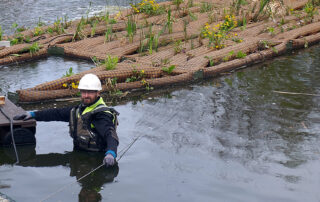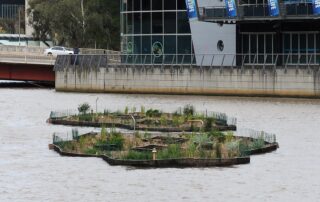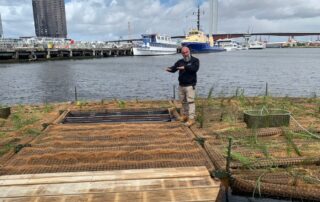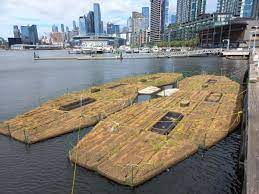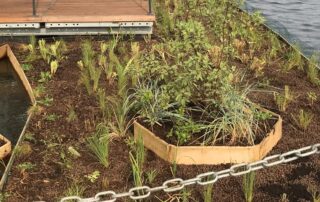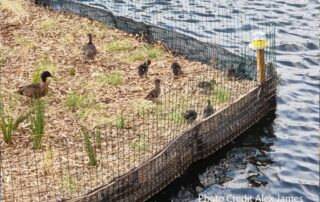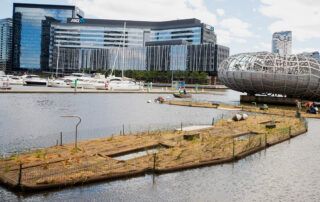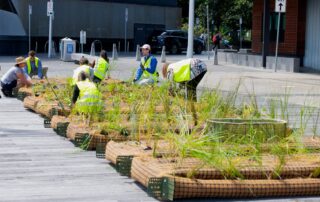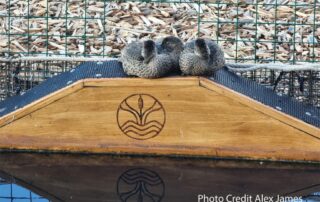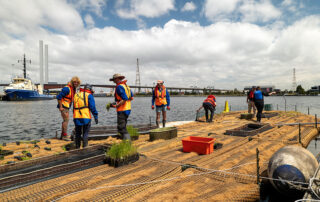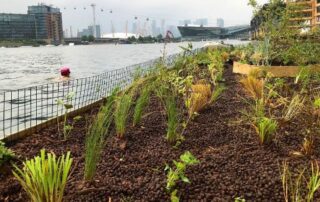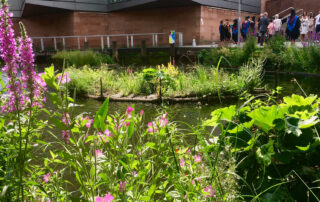Benefits of Floating Wetlands
Just like natural wetlands, the floating versions (also known as floating wetlands, floating treatment wetlands or floating islands), offer several environmental and ecological benefits including:
Water Quality Improvement:
Floating wetlands help improve water quality by providing a natural filtration system. The plants on the floating platforms absorb excess nutrients such as nitrogen and phosphorus, reducing the nutrient load in the water. They also help in the removal of pollutants and contaminants, contributing to cleaner water.
Habitat Creation:
Floating wetlands provide a habitat for various aquatic plants, insects and microorganisms. This can enhance biodiversity in water bodies and support the overall ecosystem.
Wildlife Support:
The vegetation on floating wetlands can attract and support a variety of wildlife, including birds, insects, and small aquatic animals. A subsurface forest of roots provides shelter for fish and ideal feeding grounds, improving fish stocks. This all contributes to the overall ecological balance of the area.
Aesthetic and Recreational Value:
Floating wetlands enhance the aesthetic appeal of water bodies, providing a natural and visually pleasing element. This can also improve the overall recreational value of the area, making it more attractive for people and raising the value and quality of surrounding properties.
Erosion Control:
The root systems of plants on floating wetlands help bind the soil and prevent erosion along shorelines. This can be particularly beneficial in areas where erosion is a concern.
Climate Change Mitigation:
Floating wetlands play a role in carbon sequestration as plants absorb carbon dioxide during photosynthesis. This can contribute to mitigating the impacts of climate change by helping to reduce greenhouse gas concentrations.
Educational and Research Opportunities:
These platforms can serve as living laboratories for educational purposes. They provide an opportunity for research on water quality improvement, ecological restoration, and the interaction between plants and aquatic environments.
Adaptability and Flexibility:
Floating wetlands can be deployed in a variety of water bodies, including ponds, lakes and stormwater retention basins. They are adaptable and can be customized based on specific needs and site conditions.
Low Maintenance:
Once established, floating wetlands are generally low-maintenance. The plants can grow and thrive with minimal human intervention.
Cost-Effective Stormwater Management:
Floating wetlands can be integrated into stormwater management systems to help control runoff and filter pollutants before they enter water bodies. This can be a cost-effective and environmentally friendly solution compared to traditional stormwater management infrastructure.
**While floating wetlands offer numerous benefits, it’s important to note that their effectiveness can vary based on factors such as plant selection, local conditions, and the specific goals of the project.**
Why Use a Biomatrix Floating Ecosystem Module
At WET Systems we use Biomatrix’s versatile interlocking system which can be configured to fit the site’s conditions.
 Can be tailored for specific purposes
Can be tailored for specific purposes
In addition to providing a sheltered refuge for birds and other wildlife our tailored platforms means that a mix of habitat types can be created for specific species.
 River-Ready Strength
River-Ready Strength
We use the strongest floating ecosystems available with a pull strength of over 2,500 kg. This allows our clients to install projects in challenging and dynamic water conditons.
 Design Flexibility
Design Flexibility
Five interlocking components can be configured to form hundreds of Floating Island and Floating Riverbank shapes and are connected with tough stainless steel quick connect flanges.
 Sustainability
Sustainability
Our materials are carefully selected for recycled content and recyclability and only non-toxic materials are used. Once grown, the system is typically 60% living biomass and 30% marine engineered materials.
 Product / Investment Longevity
Product / Investment Longevity
Our floating ecosystems are the longest lasting available using heavy duty marine engineering materials, including 316 Stainless Steel and HDPE with a typical lifetime of over 20 years.
 3D and 5D Planting Systems
3D and 5D Planting Systems
The multiple layers and flexible lanes of the 3D planting system support plant biodiversity. The natural open beds of the 5D planting system draw inspiration from biomimicry based on the natural integrating clay, wood, and silt substrates.
 Ease of Build
Ease of Build
Quick-connect stainless steel flanges join modules together with the capability to adjust rigidity, to pivot and to angle.
 Independent Tough Floats
Independent Tough Floats
Each float is independently manufactured and sealed to provide the strongest and longest lasting Floating Wetland available
 Flexibility in Design
Flexibility in Design
12 standard component sizes interlock to create hundreds of ecosystems shapes to match site conditions
 Specialist Solutions
Specialist Solutions
We can offer specialist solutions such as high buoyancy planters and submerged ecosystem modules which are able to create unique habitats both for people and wildlife
For more information on how WET Systems is able to help your with your Floating Wetland requirements please contact us on:
Phone: +61 (0)429 225 921
Email: office@wetsystems.com.au

